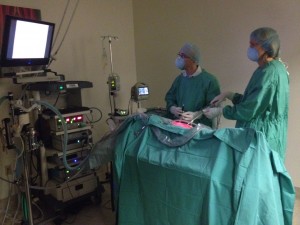Getting your pet spayed can be a daunting prospect. Dr. Mychajlonka, also known as Dr. Mych – a veterinarian at Las Vegas’s own Craig Road Animal Hospital, discusses what the various terms and options mean, what the impact on cost these options can have, and how to choose what is best for your pet.

Dr. Mychajlonka
By Kurt Mychajlonka, DVM
Female cats and dogs should have their reproductive abilities removed if they are not going to be bred. The correct term for this is spaying. Spaying can have significant health benefits for your pet in addition to also preventing the unexpected arrival of kittens, or puppies, which can add to the homeless pet problem.
There are effectively two types of spaying: traditional and laparoscopic.
With a traditional spay the uterus and the ovaries are removed through an incision in the abdomen. Because of the size of the incision, this is a great time to repair an umbilical hernia if your dog or cat has one. An umbilical hernia is a small lump of fatty tissue where the umbilical cord attached to the pet in the womb.
With a laparoscopic spay, sometimes known as a lap spay, only the ovaries are removed and the procedure only requires two mini incisions. The smaller incisions associated with a lap spay cause less post operative pain than with a traditional spay and that leads to a faster recovery time. There is also less need for restricting activities which makes lap spaying great for very active dogs. Because of the additional equipment and people required for a laparoscopic procedure, lap spays tend to be more expensive than lower cost options. At Craig Road Animal Hospital we try to keep the procedure competitively low cost for a spay as possible.

Dr. Mychajlonka performing a Lap Spay.
Of course, whether for traditional spaying or for a lap spay, Craig Road will be only too happy to see you and your pet. In addition to the choice between traditional spaying and laparoscopic spaying there are other options that most veterinary practices will offer and need to be thought about. All anesthetic procedures have some inherent risk – most of the items below are about minimizing these risks.
Preoperative Blood Work
Just like with humans, blood tests are a great way of giving a general snapshot of the health of your dog or cat before any procedure. This becomes particularly important when your pet is over five years of age as that is when problems with the liver and kidneys can appear but have no external symptoms. Liver and kidney function are important because those organs metabolize the anesthesia used in most procedures for dogs and cats. In order to keep a low cost option for owners we offer preoperative blood work as an optional extra depending on the age and medical history of your pet.
I.V. Catheter
An intravenous catheter allows fluids to given to a patient during the procedure – keeping their blood pressure up and keeping the patient hydrated. Additionally, an I.V. Catheter gives the doctor direct access to a vein to give an intravenous injection in an emergency. At Craig Road Animal Hospital we feel that this is so important that we do not have an I.V. Catheter as an optional extra but included in the price of every surgery – including low cost spays and neuters.
Pain Control
Injections and tablets to go home, after a spay, are all about controlling the amount of discomfort your pet experiences post-op (after the operation). Even with laparoscopic procedures there is a certain amount of post operative discomfort so some kind of control is always recommended. At Craig Road, we do not feel that pain control is optional and so it is included in the cost of both traditional and lap spays.
Micro Chipping
A pet microchip is a small device that is implanted under the skin that is embedded with a unique number. When this number is registered with your contact information it provides an easy way for veterinarians and rescue organizations to reunite lost dogs and cats with their owners. Microchips can be implanted while your pet is awake with just a small amount of discomfort; however, when your pet is being spayed or neutered is a great time to do it as your pet will feel nothing.
For many people spaying their pet is the first veterinary surgical procedure they have ever been involved with, if indeed not the first surgical procedure period! It can be confusing and scary – our job is to answer your questions and give you all the information to make an informed choice about what is right for you and your pet; whether that be a traditional spay vs. a lap spay, pre-operative blood work, I.V. cathers, pain medications and / or pain control.
Please feel free to ask any of our staff next time you are at Craig Road Animal Hospital, give us a call or email, or post in the comments below.

